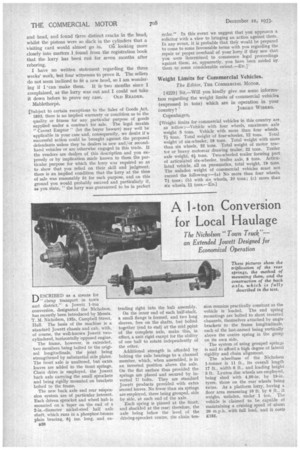A 1-ton Conversion for Local Haulage
Page 36

If you've noticed an error in this article please click here to report it so we can fix it.
The Nicholson " Town Truck"— an Extended Jowett Designed for Economical Operation
ESCRIBED as a means for " cheap transport in town and district," a Jowett 1-ton conversion, designated the Nicholson, has recently been introduced by Messrs. T. M. Nicholson, 192a, Campbell Street, Hull. The basis of the machine is a standard Jowett chassis and cab, with, of course, the well-known Jowett twocylindered, horizontally opposed engine.
The frame, however, is extended, two members being bolted to the original longitudinals, the joint being strengthened by substantial side plates. The front axle is unaltered, but extra leaves are added to the front springs. Chain drive is employed, the Jowett back axle carrying the small sprockets and being rigidly mounted on brackets bolted to the frame.
The new back axle and rear suspension system are of particular interest. Each driven sprocket and wheel hub is mounted on a taper on the end of a 2-in.-diameter nickel-steel half axle shaft, which runs in a phosphor-bronze plain bearing, 81 ins, long, and 30
tending tending right into the hub assembly.
On the inner end of each half-shaft, a small flange is formed, and two long sleeves, free on the shafts, but bolted together (end to end) at the mid pint of the complete axle, make this, in effect, a unit rigid except for the ability of one half to rotate independently of the other.
Additional strength is afforded by bolting the axle bearings to a channel member, which, when assembled, is in an inverted position above the axle. On the flat surface thus provided the springs are placed and secured by inverted U bolts. They are standard Jowett products provided with extra second leaves. No fewer than six springs are employed, three being grouped, side by side, at each end of the axle.
Each spring is pinned at the front, and shackled at the rear; therefore, the axle being below the level of the driving-sprocket centre, the chain ten
sion remains practically constant as the vehicle is loaded. The end spring mountings are bolted to short inverted channels, themselves attached by angle brackets to the frame longitudinals, each of the Last-named being vertically above the centre spring in the group on its own side.
The system of using grouped springs is said to afford a high degree of lateral rigidity and chain alignment.
The wheelbase of the Nicholson 1-tonner is 11 ft., its overall length 17 ft., width 6 ft., and loading height 3 ft. Lynton disc wheels are employed, being shod with 4.50-in. by 19-in. tyres, those on the rear wheels being twins. As a platform lorry, having a floor area measuring 10 ft. by 6 .ft., it weighs, unladen, under 1 ton. The vehicle is claimed to be capable of maintaining a cruising speed of about 20 m.p.h. with full load, and it costs £185.












































































